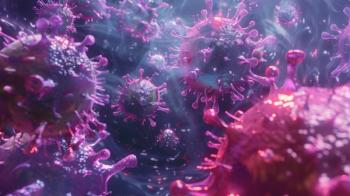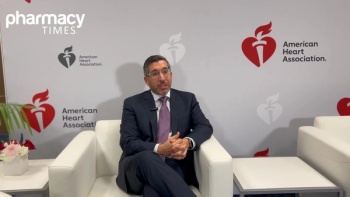
Study Finds Distinct Differences in Cytokine Response in Rhinovirus vs RSV
Respiratory syncytial virus- and rhinovirus-induced wheezing illnesses differ from each other at multiple levels.
The most common cause of hospitalization in children is bronchiolitis. Respiratory syncytial virus (RSV) and rhinovirus (RV) are the most prevalent etiologic agents.
While RSV typically causes more severe bronchiolitis, RV etiology is commonly associated with a higher risk of recurrent wheezing and asthma than RSV etiology. A recent
This study population included patients from the Vinku 2 study, in which RV-infected first-time wheezing children were randomized to receive oral prednisone (2 mg/kg/day for 3 days) or placebo. Inclusion criteria were being aged 3-23 months, delivery at ≥36 gestational weeks, first wheezy episode (parental report and confirmed by medical records), sole steroid-naïve RV or RSV infection detected in a nasopharyngeal aspirate sample by polymerase chain reaction (PCR), and written informed consent from a parent or guardian. Recruitment was held in 2007-2010 in the Department of Pediatrics, Turku University Hospital, and 113 children were enrolled.
The mean age of the participants was 12.5 months [interquartile range (IQR) 7.4-15.9], 69% were male, 80% were treated as inpatients, 29% were atopic, and 20% had atopic eczema. Children infected with RV were older and heavier, had a higher blood eosinophil count, and had fewer preceding symptoms (wheezing, cough, rhinitis, fever) all P <.05.
At the start of the study, the authors noted differences in cytokine response from peripheral blood mononuclear cells (PBMC) between the RV and RSV groups in response to anti-CD3/anti-CD28 stimulation. In adjusted analyses, when compared to the RSV group, the RV group was characterized by a lower expression of interleukin 1 receptor antagonist (IL-1RA) (median 240 vs 97 pg/ml), interleukin 1 beta (1L-1β) (30 vs 3.5), and monocyte chemoattractant protein-1 (MCP-7) (7,500 vs 6900) and a higher expression of eotaxine-2 (350 vs. 740), thymus- and activation-regulated chemokine (TARC) (1.8 vs 3.9), and epithelial-derived neutrophil-activating peptide 78 (ENA-78) (210 vs. 900) during the acute phase (all P <.05).
Two weeks after the start of the study, in adjusted analyses, the cytokine profile of the RV group was characterized by a higher expression of fractalkine when compared to the RSV group (median 15 vs. 8.3 pg/ml, P = .02). An analysis of the change in cytokine expression between the acute and convalescent phases demonstrated an increased expression of fractalkine (median 1.1 vs. -4.6 pg/ml) and IL-1β (5.0 vs. -6.8, respectively) in the RV group, whereas in the RSV group, the expression was decreased (all P <.03).
Additionally, the RV group was characterized by a decreased expression of I-309 (median -8.4 vs. 10 pg/ml) and TARC (-0.96 vs. 1.4), whereas in the RSV group, the expression was increased (all P <.05). A difference in the change in cytokine secretion was also observed with IL-6, but it did not reach significance (P = .06).
Given this, several statistically significant interactions between the virus group and cytokine response were observed (all P < .04), demonstrating that the effect of cytokine response from PBMCs was different in the RV and RSV groups in terms of hospitalization time. Increased expression of interferon gamma (IFN-γ), macrophage-derived chemokine (MDC), IL-1RA, and vascular endothelial growth factor (VEGF) was associated with shorter hospitalization times in the RSV group (all P <.02), but in the RV group, this difference was not significant (all P >.69). A significant virus group vs cytokine expression interaction was observed with IL-6, but the expression of IL-6 was not associated with the duration of hospitalization in the RSV or RV group (all P >.08).
Although the incidence of relapses within 2 and 12 months differed between the RV and RSV groups [52% vs. 11% (P = .02) and 81% vs. 22% (P = .002), respectively], the exact cytokine response for this difference remained unknown because of the lack of relapses in the RSV group. However, in the RV group, a decreased expression of I-309 (CCL1) and TARC during the acute phase was associated with the occurrence of a new physician-confirmed wheezing episode within 2 months (median, relapse vs no relapse, 21 vs 48, P = .049, and 3.0 vs 7.0, P = .03, respectively).
Overall, the study showed there are distinct difference between cytokine responses from PBMCs and RV- and RSV-induced first wheezing episode, notably in the acute phase; there is an association between the cytokine response from PBMCs and the severity of acute illness between the 2 virus groups; and specific cytokine responses from PBMCs were associated with medium-term prognosis in the RV group.
In conclusion, the offers noted, “Our current study and earlier trials support the emerging assumption that RV- and RSV-induced wheezing illnesses differentiate from each other at multiple levels––from clinical manifestation to cellular responses manifested by altered cytokine and chemokine profiles.”
Reference
Hurme P, Komulainen M, Tulkki M, et al. Cytokine expression in rhinovirus- vs. respiratory syncytial virus-induced first wheezing episode and its relation to clinical course. Front Immunol. November 14, 2022. https://doi.org/10.3389/fimmu.2022.1044621
Newsletter
Stay informed on drug updates, treatment guidelines, and pharmacy practice trends—subscribe to Pharmacy Times for weekly clinical insights.















































































































































































































